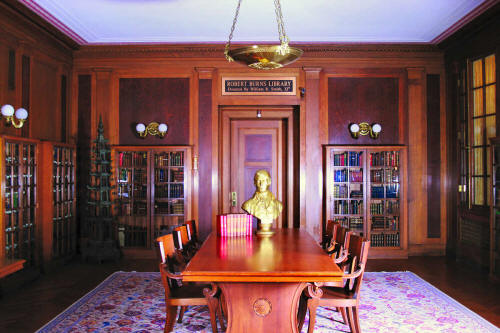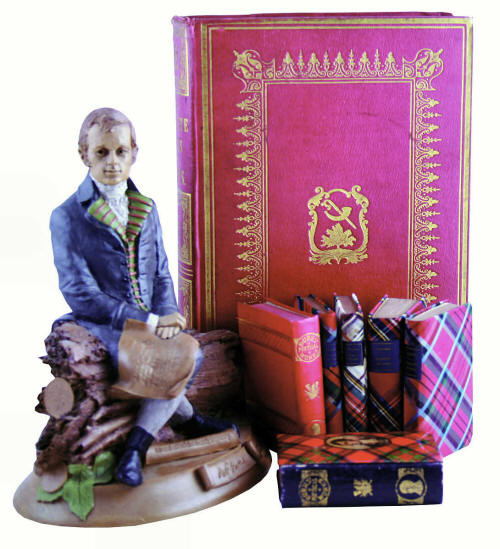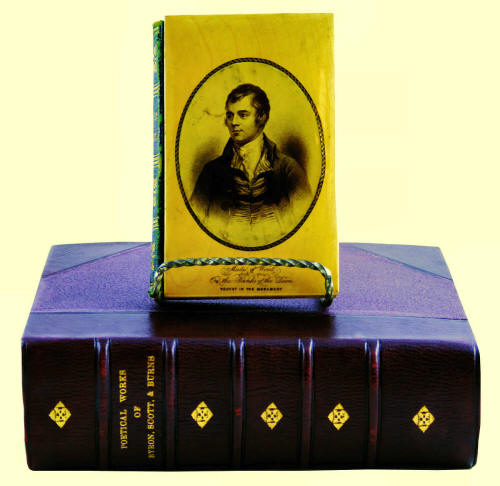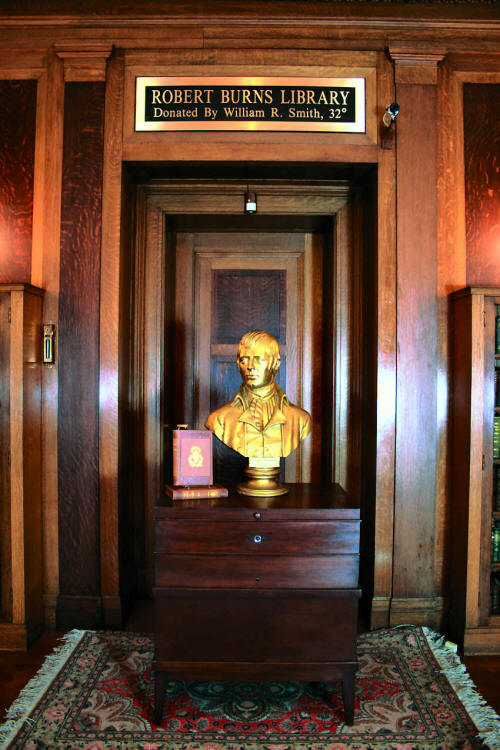|
A Bibliography of the William R. Smith Collection
In the Library of the Supreme Council, 33ş, S.J.
Larissa P. Watkins, Author
Joan K. Sansbury, Editor
Robert G. Watkins, Jr., Consultant
Akram Elias, Grand Master to Free and Accepted Masons
Reviewed by Frank R. Shaw, FSA Scot, Dawsonville, GA, USA
Email: jurascot@earthlink.net

This is a handsome book, beautifully adorned with many
fine postage-sized illustrations and one of the best kept secrets in America
-- the William R. Smith Collection of Robert Burns. This collection has been
dormant since the death of the collector in 1912, and this book has been
published in anticipation of the 250th celebration of the birth
of Robert Burns. It is one of many books you will see celebrating the birth
of Burns in the coming year.
The article on Burns is of interest to those who are not
familiar with the Masonic aspect of the poet’s life. Of equal note, if not
more so, is an article by Kevin Fries on the life of the collector, William.
R. Smith. Neither the collection nor the collector is well known outside the
Masonic community, so Mr. Fries basically introduces Smith to the general
public. I’m sure we will hear more from Kevin Fries in the future about this
great Burnsian. I must add that the descriptions of each entry in the book
are pleasant and pleasing to the reader. One can tell that much planning and
energy went into the publication of the book. I am further compelled to say
that author Larissa Watkins has kindly answered my questions and provided
explanations where needed. I appreciate the courtesies extended to me by Ms.
Watkins during the course of writing this review.
William Robertson Smith bought his first copy of Burns’
work as a young boy in Scotland, and he continued to collect Burns
throughout a long career as a horticulturalist and as Superintendent of the
National Botanic Garden in Washington, D.C. for over 40 years. From the
Burns Centenary in 1896, Smith worked with the friendly interest and
financial backing of Andrew Carnegie during the last 15 years of his life to
build a collection consisting of both Scottish books and publications by and
about Burns. The books were stored in a wee cottage on the grounds of the
Botanic Garden. According to an account in The Scottish Rite Journal,
few people were aware of the treasures stored inside the cottage.

Since becoming acquainted with the Smith Collection and
the relationship of Andrew Carnegie with William Smith, I have wondered why
the collection does not boast a Kilmarnock edition of Poems Chiefly in
the Scottish Dialect. It cannot be because there was no money
available since Mr. Carnegie, the famous Scottish-American who built many
libraries around the world, is on record as patron of the Smith Collection.
However, if Carnegie was known then as now for anything, it was for his
philanthropy, and today his foundation is valued at well over $1.3 billion.
The case of the missing Kilmarnock in the Smith Collection just doesn’t make
sense to me.
Smith wanted the collection kept together after his death
and with that goal in mind, Carnegie who was appointed by Smith as a trustee
of the Burns collection, approached both the Library of Congress and the
Public Library in Washington. Ironically, there “was no room in the inn”,
neither of them. At times this is the case, but sometimes the “no room”
reply is used to not accept collections because of the strings attached to a
gift of books. Later, the decision was made to house the collection in the
newly completed House of the Temple. As Mr. Smith stipulated in his will,
the collection has been open to the public ever since, and he is on record
as stating, “I am Scotch-American, and I intend that this collection shall
go to the American People.”
All well and good but how do you translate his good
intentions to serve the public with the braggadocio of a few well meaning
people? In all the years I have written book reviews, I have never written a
negative review. This is my first! With that said, it is highly unusual for
me to raise a red flag about a book, but as we go along with this review,
you will see my concern.

Pay attention to the first two sentences in the book’s
Foreword: “The Library of the Supreme Council of the Ancient & Accepted
Scottish Rite, Southern Jurisdiction, U.S.A., is the repository of the most
complete collection of the literary works of Robert Burns and Burnsiana in
America. It is also important to note that this collection, known as the
William Robertson Smith Collection, is the second largest compilation of
Burns materials in the world, ranking only behind the collection maintained
in The Mitchell Library in Glasgow, Scotland.”
The above noted author, editor, consultant and Grand
Master have affixed their names to this book, and I can only assume they
accept as truth these two sentences. With all due respect to them, both
sentences are flat wrong!
Where are the facts? Well, just because someone said
something years ago does not make it true today. What sort of research, if
any, was conducted by those responsible for the book to reach the conclusion
that their collection is bigger and better today than any outside Scotland?
Is this sloppy research, a lack thereof, or just plain arrogance?
I must regretfully inform them that not only is the
William. R. Smith Collection not “the most complete collection of the
literary works of Robert Burns and Burnsiana in America”, it is also not
“the second largest compilation of Burns material in the world”. That
distinction belongs to another collection that I shall tell you about as we
go along.
I have corresponded with the author about the statement
in the Foreword and Ms. Watkins’ answer follows: “From one hand it might be
some sort of legend (everybody would like to be First, or at least Second).
From another hand it will remain a true (sic) until somebody from University
of South Carolina is going to do a comparative bibliography of Burn’s works
from 1786 to 1911 of G. Ross Roy’s Collection with our Burnsiana.” If I were
a trial attorney, I’d use the first part of that reply and say to the jury,
“I rest my case!” As to the second part of her reply, while I appreciate the
author’s statement, I cannot agree that “somebody from the University of
South Carolina is going (needs) to do a comparative bibliography of Burns
works”. I can do it myself.
We all are capable of doing our own research if we chose.
Some do, some don’t. I do. I have purchased the Smith bibliography and have
read it and referred to it numerous times. I have also studied the materials
available online about the Roy Collection. Further inquiry with personnel at
USC’s Thomas Cooper Library found that a bibliography is in the process of
being prepared for publication, and I have since acquired a preliminary
copy. I have studied the two collections at length and compared them to each
other. I do not need anyone, scholar or not, to tell me the results of
something I can see for myself. The evidence is clear enough to
support the University of South Carolina’s G. Ross Roy Robert
Burns Collection as the largest and most comprehensive Burns collection
outside of Scotland.

It is evident the good folks writing about the Smith
Collection were aware of the Roy Collection at the University of South
Carolina. They could have “Googled” the Roy Collection and found enough
information about it to have raised some caution on their part for
proclaiming the Smith collection the biggest and best. At the time of their
publication they, of course, were unable to receive a preliminary copy of
the Roy bibliography since it is just now in its pre-publishing stage.
Regardless, with the available Roy Collection information on the internet,
someone could have inquired, “Are we really all that we have said we are or
has that collection down in South Carolina replaced our Burns collection as
the most comprehensive?” At the very least, someone could have picked up the
phone and called the USC Thomas Cooper Library to get details on the Roy
collection. It would have saved them some embarrassment of proclaiming the
superiority of their Smith Collection. Egg on one’s face is not a pretty
sight, with or without a bib!
Let’s look at just a few comparisons of the two
bibliographies. First, as mentioned earlier, the Smith Collection does not
have a first edition of the 1786 Kilmarnock which they readily acknowledge.
In Chapter I of the book’s “Bibliographical Entries” entitled “Works of
Robert Burns”, this sentence is found: “The William R. Smith Collection does
not contain the original Kilmarnock Edition.” Instead, McNaught’s 1909
facsimile of the 1786 Kilmarnock Edition is used as an illustration. The Roy
Collection does have a Kilmarnock Edition. It is one thing to have a
facsimile of the most coveted Burns book in the world, and it is another
thing to hold “the real thing” in your hands. Why is this book so important?
It is widely held by Burnsians in the know that of the 612 copies of the
Kilmarnock Edition published July 31, 1786, fewer than 70 copies are known
to survive today.
The Smith Collection does have a copy the second edition
(the 1787 Edinburgh edition of Poems Chiefly in the Scottish Dialect),
but two variants were printed that year and the Smith Collection does not
identify which of the two states is in their collection. (Nor does the
format of the book tell the reader if they have more than one copy.) The Roy
Collection has several copies of each of the two states.
Most importantly, however, I did not see in the Smith
Collection a copy of The Scots Musical Museum by James Johnson
or George Thomson’s Select Collection of Original
Scotish Airs. (Yes, one “t” in earlier versions.) Listen up! Robert
Burns only spent the last ten years of his life collecting, writing,
modifying, mending, fixing, or rearranging these wonderful songs of
Scotland. Both the Johnson and Thomson books contained hundreds of songs by
Burns. This was his gift to his country. The Roy Collection has originals of
both. The Smith Collection has neither!
Dr. Ross Roy recently gifted over 20 original manuscripts
to the Thomas Cooper Library at the University of South Carolina. These are
original manuscripts as penned by Robert Burns himself. They consist of
letters and poems. The Smith Collection does not boast one original
manuscript or song by Burns.
There is no mention of the 1799 edition of The
Merry Muses of Caledonia being a part of the Smith Collection, nor
of any subsequent edition. The Roy Collection has one of the only two known
original copies of the 1799 edition in existence and “the only one with a
complete title page”. But, in deference to Mr. Smith and the times he lived,
perhaps he did not agree with that part of Burns’s writing. But most Burns
scholars will agree that to know Burns, you have to know all of Burns and
bawdry songs and poems, risqué matters for polite company, were a part of
his day and a part of his life. A coin has two sides. You can’t have one
without the other. The same is true about Burns. You have to have both sides
of him to have the complete Burns.
In addition to this original copy of The Merry
Muses in the USC Thomas Cooper Library, there are 18 other editions,
states, and variant printings of The Merry Muses on the market
before 1912, the year of Mr. Smith’s death. So, copies of this book were
available for Mr. Smith to collect, as was the Kilmarnock, had he chosen to
do so. Remember, Mr. Carnegie was his patron.

There is a great section of the Smith bibliography
dealing with so-called “Chapbooks”, small paperbacks geared for the average
man’s income, and the Smith Collection lists 241 of them. The problem is
that they only contain a few about Burns, and I am being lenient on that
point. I actually found only two with Burns’ name in the title. A few others
had a song or a poem in the contents. It would be best suited to list the
chapbooks as part of a Scottish Collection, not Burns.
Let’s look briefly at both bibliographies. Mr. Smith’s
bibliography consists of 161 pages (8˝x11) sans index, and Dr. Roy’s
bibliography has 378 pages (6x9) sans index. The Smith Collection has 1,202
total Burns items (again some, as in the chapbook section, are not about
Burns, so you could easily drop that number to around a thousand and that is
being generous) while the Roy Collection has over 5,200 on Burns alone. The
total Scottish collection of Mr. Smith is 5,500 while the Roy Collection has
over 20,000 total Scottish volumes.
I could go on about the differences of the two
collections but there is no need. I inquired of Ms. Watkins if the Smith
Collection had remained dormant since Mr. Smith passed away in 1912 or if
additional books had been purchased or given to the collection. “Yes, this
collection remained dormant” was her reply. Suffice it to say that the Roy
Collection is on-going, vibrant, alive, and has been endowed by Dr. and Mrs.
Roy to continue acquiring Burns items in the future. Just recently a replica
of the skull of Burns was added to the collection. It was brought back to
America from Scotland by the 84-year-old emeritus professor himself. And I
feel it is a safe bet that something has been added to his collection as
you’ve read this article.
Let me say I am not a Mason and certainly have no quarrel
with this worthy organization. I have the highest respect for the Masons,
and I am aware of the good works they have performed around the world in the
name of humanity and have admired their benevolence and generosity over the
years. I am aware of the high regard Robert Burns had for the Masons and his
involvement with them. But this review is not about good works, it is about
sloppy research. To put it simply, in this case, someone somewhere did not
do their homework.
Andrew Carnegie was a friend of Mr. Smith, a patron of
his collection, and some say he is the one who supposedly proclaimed the
Smith Collection the best outside of Scotland. I have been unable to locate
that quote from Carnegie, and in a follow-up email with Mr. Fries, who wrote
the book’s refreshing article on Mr. Smith, I learned neither has he.
I discovered, however, in the January 1997 publication of
the Mason’s The Scottish Rite Journal that the Librarian of
the Edinburgh Public Library and his associates came to the United States to
catalog the Smith Collection soon after it was moved to Alexandria. They
stated, “We are impressed by the number and rarity of its editions which are
beyond what is in the British Museum and exceeded only by the Mitchell
Library collection in Glasgow.” It probably was true when the collection
first opened to the public in 1919 but is not the case now, nearly a hundred
years later, no matter who says it, Grand Master, librarian or common
citizen.
Subject: Response on review
Dear
Mr. Shaw,
Thank
you so much for mentioning our catalog on
electricscotland website. In response, I would like to
present my own personal viewpoint concerning your comments.
I am
sorry for having my Russian mind upside-down, but I didn’t see a
book review in your piece at all. What I did see was a quite unfair
attack only on the two first sentences of Mr. Elias introduction
(what if Akram would have written that our collection is 25th
on the rank?). What would be the point of your “review” then? Why
then the high appraisal for Roy’s collection be
necessary? After all, a University Library is an academic Library,
and its primary goal is to continue to collect what ever the
collection might be for the sake of education.
O,
yes, we might argue on details and we might show how smart we are to
do our own comparative biography, etc., but in this particular case
we should be more aware and more sensitive about the spiritual value
of this enterprise. We would be missing the main point – love to
Rabby Burns!
I
understand the overall situation here to be a little bit different.
I am not a Great Scot, but I am proud for the Fraternity, which one
hundred years ago accepted this collection and continues to
preserves it in one of the most beautiful rooms in the House of the
Temple. I am proud for the Fraternity, which found it possible to
publish a beautifully illustrated catalog as a token of high
respect, admiration, and love for Robert Burns – the epitome of the
Spirit of the Scottish Nation. I am proud of my colleagues, who
expressed their brotherly veneration for Robert Burns (in this
context their “sloppy research” should be forgiven.)
I
understand - you are a Great Scot and your independent nature calls
you to fight despite of the fact that there are no enemies around,
only friends.
However, I want to believe that you do like our catalog, because it
connects the name of Robert Burns with two great Presidents of our
country – Washington and Lincoln.
I
want to believe that you do like our catalog, because it introduced
you to another Great Scot – William Robertson Smith and his amazing
gift to all of us.
I
want to believe that you do like our catalog, because of the dozens
of images which are dearest to your soul and let you emotionally be
more close to Rabby and to your
motherland.
I
want to believe that you do like our catalog, because it gives you a
rare opportunity to enjoy quotations from dozens of books about
Robert Burns, and let your heart respond in admiration for him.
And,
importantly, I want to believe we’ll remain friends, because of our
mutual affection to Caledonia Bard!
My
very best wishes for Happy, Healthy, and Prosper New Year,
Larissa
It has always been my
desire to be as fair as possible to any book I review and that goes for
the author as well. It is for this reason that I elect to print this
response to the review from the author. My final remarks on this subject
is that The Smith Collection in Washington, D. C. is a first class
collection, top drawer, one to be proud of and one of the finest in the
world. BUT, it is a long way from being the top Burns Collection in
America, and neither does it rank just behind the collection at the
Mitchell Library in Glasgow. It may have at one time but today that
honor belongs to the G. Ross Roy Collection at the
University of South Carolina and I challenge anyone to
make an item by item comparison and come up with a different conclusion.
I again extend my thanks to the author, Ms. Larissa Watkins for her many
courtesies and help while writing the review and to Ms. Jeri Walker for
supplying the pictures used in the article. (FRS: 1.05.08)
|
